New therapeutic strategy against sleeping sickness

A newly developed small molecule selectively kills the pathogen causing sleeping sickness and Chagas disease. Scientists from the Helmholtz Zentrum München, along with colleagues from the Technical University of Munich and the Ruhr University Bochum, report these findings in Science. The trick: The researchers could first determine the parasite's Achilles heel by using modern structural biology techniques and then develop an inhibitor with a perfect fit.
Trypanosomes get their name from the Greek trypano- (borer) and soma (body). The protozoan parasites are responsible for various diseases, particularly in Latin America and Africa. The best known example is probably sleeping sickness, which is caused by trypanosomes and transmitted by tsetse flies. In the end stage, patients suffer from uncontrollable sleep, which gave the sickness its name.
"Until now, there have been only a few medications against trypanosomes. These drugs have many undesirable side effects, and first cases of resistance are already spreading," explains Prof. Dr. Michael Sattler, Director of the Institute of Structural Biology at the Helmholtz Zentrum München and Professor of Biomolecular NMR Spectroscopy at the Technical University of Munich. Together with Dr. Grzegorz Popowicz (also Helmholtz Zentrum München) and the group headed by Prof. Dr. Ralf Erdmann at Ruhr University Bochum, the research team sought new possibilities to deactivate the pathogen. "We primarily concentrated on the so-called PEX proteins, which have been under debate as potential targets for pharmacological interference for some time," says Sattler.
PEX proteins are the key
The PEX proteins play a crucial role in the function of the so-called glycosomes. These are small cell organelles that are important to maintain the parasite's sugar metabolism. "The idea was to prevent the interaction between two essential proteins, PEX14 and PEX5, and consequently to disrupt the trypanosome metabolism so effectively that the parasites cannot survive," explains Grzegorz Popowicz. At the Bavarian NMR Center, a joint research infrastructure of the Helmholtz Zentrum and TU München, the researchers therefore first used nuclear magnetic resonance (NMR) to investigate the structure of the two target proteins.
In the next step, the teams from Munich and Bochum used the thus determined spatial structure to optimize a substance that specifically binds to PEX14, thereby preventing the interaction with PEX5, which eventually kills the parasite. Grzegorz Popowicz describes it as, "We more or less first measured the lock and then developed the right key for it."
Possibly also relevant for other parasites
In the future, the researchers want to further advance these molecules using medicinal chemistry so that they can be tested in clinical studies and, eventually may be approved as drugs. They are also examining the extent to which the approach is suitable to kill other single-cell parasites that may depend on similar proteins. "One possibility would be to target the Leishmania parasite," explains Popowicz. Future research in this direction will follow.
More information: M. Dawidowski et al. Inhibitors of PEX14 disrupt protein import into glycosomes and killparasites, Science (2017). DOI: 10.1126/science.aal1807
Journal information: Science
Provided by Helmholtz Association of German Research Centres



















